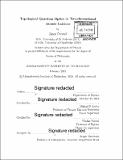| dc.contributor.advisor | Mikhail D. Lukin and Vladan Vuletić. | en_US |
| dc.contributor.author | János, Perczel, | en_US |
| dc.contributor.other | Massachusetts Institute of Technology. Department of Physics. | en_US |
| dc.date.accessioned | 2020-01-08T19:42:51Z | |
| dc.date.available | 2020-01-08T19:42:51Z | |
| dc.date.copyright | 2019 | en_US |
| dc.date.issued | 2019 | en_US |
| dc.identifier.uri | https://hdl.handle.net/1721.1/123405 | |
| dc.description | Thesis: Ph. D., Massachusetts Institute of Technology, Department of Physics, 2019 | en_US |
| dc.description | Cataloged from PDF version of thesis. | en_US |
| dc.description | Includes bibliographical references (pages 187-204). | en_US |
| dc.description.abstract | A key goal in quantum science is to build quantum systems that are robust to disorder and experimental imperfections. The application of topology to quantum physics is one of the most promising avenues towards achieving this goal, since topological systems are generally insensitive to moderate, local perturbations. This thesis is dedicated to the introduction and analysis of novel platforms for engineering topological states in the optical domain. First, we analyze the interaction of atoms in Maxwell's fish eye lens, which is an optical medium mimicking light propagation on the surface a sphere. Due to the underlying (trivial) spherical topology of the system, light follows circular trajectories in the lens, giving rise to special focusing properties. We investigate the long-range atomic interactions mediated by the lens and the efficiency of entangling operations. We then turn our attention to two-dimensional atomic arrays in free space, where interactions are mediated by photons. We show that in the presence of a uniform magnetic field, the system exhibits a photonic band structure with non-trivial Chern numbers and a topological gap. We explore the topological edge states that arise on the system boundaries, identify the conditions under which edge states are long-lived and show that they are robust to imperfections in the lattice. Finally, we study two-dimensional atomic emitter arrays embedded in photonic crystals. We engineer a quasi-two-dimensional photonic crystal slab that mediates long-range dipolar interactions between emitters and gives rise to topological behavior. We analyze the topological edge states of the system and show that they are robust to the inhomogeneous broadening of the emitters and to missing lattice sites. | en_US |
| dc.description.statementofresponsibility | by Perczel János. | en_US |
| dc.format.extent | 204 pages | en_US |
| dc.language.iso | eng | en_US |
| dc.publisher | Massachusetts Institute of Technology | en_US |
| dc.rights | MIT theses are protected by copyright. They may be viewed, downloaded, or printed from this source but further reproduction or distribution in any format is prohibited without written permission. | en_US |
| dc.rights.uri | http://dspace.mit.edu/handle/1721.1/7582 | en_US |
| dc.subject | Physics. | en_US |
| dc.title | Topological quantum optics in two-dimensional atomic lattices | en_US |
| dc.title.alternative | Topological quantum optics in 2-D atomic lattices | en_US |
| dc.type | Thesis | en_US |
| dc.description.degree | Ph. D. | en_US |
| dc.contributor.department | Massachusetts Institute of Technology. Department of Physics | en_US |
| dc.identifier.oclc | 1133650597 | en_US |
| dc.description.collection | Ph.D. Massachusetts Institute of Technology, Department of Physics | en_US |
| dspace.imported | 2020-01-08T19:42:50Z | en_US |
| mit.thesis.degree | Doctoral | en_US |
| mit.thesis.department | Phys | en_US |
